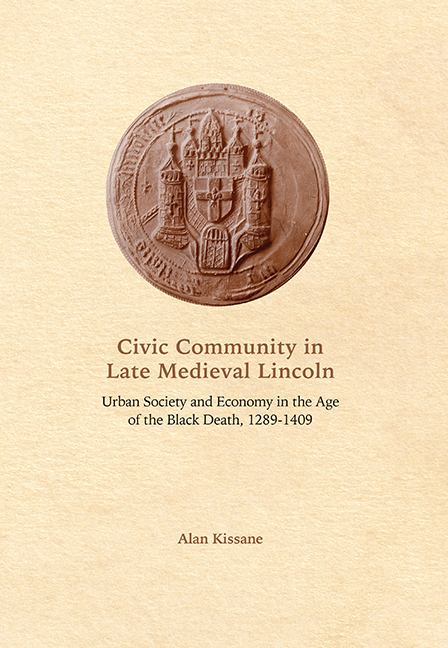 Civic Community in Late Medieval Lincoln
Civic Community in Late Medieval Lincoln Book contents
- Frontmatter
- Contents
- List of Illustrations
- Acknowledgements
- Abbreviations and Note on the Text
- Introduction
- 1 Urban Foundations: Occupational Structure
- 2 Lincoln as Entrepôt: Tolls, Trade and Credit
- 3 The Crown and the Fee Farm
- 4 The Growth of Civic Government
- 5 Fraternity, Orthodoxy and Communal Cooperation
- 6 Chantry Founders, Commemoration and the Rental Market
- Conclusion
- 1 Appendix 1: Occupational Sources and Data
- 2 Appendix 2: Lincoln Civic Officials, 1289-1409
- 3 Appendix 3: Lincoln Members of Parliament, c.1290-1410
- 4 Appendix 4: The Fraternal Year
- 5 Appendix 5: Perpetual Chantry Foundations
- Bibliography
- Index
1 - Urban Foundations: Occupational Structure
Published online by Cambridge University Press: 27 April 2017
- Frontmatter
- Contents
- List of Illustrations
- Acknowledgements
- Abbreviations and Note on the Text
- Introduction
- 1 Urban Foundations: Occupational Structure
- 2 Lincoln as Entrepôt: Tolls, Trade and Credit
- 3 The Crown and the Fee Farm
- 4 The Growth of Civic Government
- 5 Fraternity, Orthodoxy and Communal Cooperation
- 6 Chantry Founders, Commemoration and the Rental Market
- Conclusion
- 1 Appendix 1: Occupational Sources and Data
- 2 Appendix 2: Lincoln Civic Officials, 1289-1409
- 3 Appendix 3: Lincoln Members of Parliament, c.1290-1410
- 4 Appendix 4: The Fraternal Year
- 5 Appendix 5: Perpetual Chantry Foundations
- Bibliography
- Index
Summary
If population alone is used as an indicator of urban status, it is clear that Lincoln was one of the most important English towns during the later Middle Ages. Yet what is it that marked out county towns, such as Lincoln, from other lesser towns and how was this reflected by local occupational structure? While existing work on this issue has shown that towns of different sizes and status often had common characteristics, such as guild foundations, hospitals, monasteries or a weekly market, for example, larger towns nevertheless maintained ‘more specialist activities and a deeper social structure than their smaller neighbours’, which came to be reflected by their greater diversity of trades. More populous towns likewise maintained larger spheres of influence which, according to ‘central place’ theory, attracted consumers and traders from further afield than smaller towns and saw them become the focus for a region's trade, goods and services. Together with these smaller centres, county towns formed an interlocking and interdependent regional hierarchy. Such a theory might reasonably be used to describe the position of Lincoln during the later Middle Ages, which not only housed the see of the bishop of Lincoln at the cathedral and the shire court and county gaol of the sheriff at the castle, but also a large civic government ruled by a strong and wealthy mercantile elite. To these important institutions must also be added Lincoln's numerous specialist markets, its capacity to hold public entertainments and events, including tournaments, jousting and public preaching, peace treaties and even parliament itself, and its focus as a centre of pilgrimage and finance.
An equally essential function of many large (and small) towns was their local manufacturing or trading specialism, which provided employment for dozens if not hundreds of local workers. Chief amongst these specialisms was the cloth trade which came to dominate the economies of Colchester, Coventry, Norwich and Salisbury during the fourteenth century, for example. For Salisbury in particular, John Hare has estimated that by 1377 at least a quarter of the entire male adult population worked within the trade (approximately 400). Elsewhere large numbers of workers have been identified for the iron industry at York and Gloucester during the fourteenth century, whilst at Newcastle there was a large and prosperous coalmining community.
- Type
- Chapter
- Information
- Civic Community in Late Medieval LincolnUrban Society and Economy in the Age of the Black Death, 1289-1409, pp. 17 - 49Publisher: Boydell & BrewerPrint publication year: 2017


